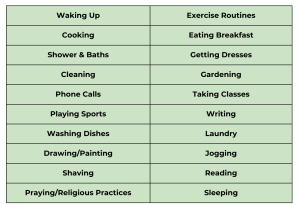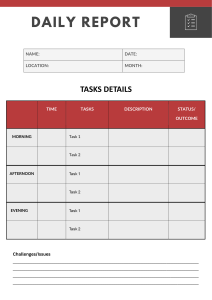1 Intermediate
Erika Marcos
Chapter 1: My Daily Life
Learning Objectives
At the end of the lesson, students are expected to:
-
Describe daily routines through sharing and discussion
-
Create a chart or diagram for writing a daily activities report
-
Develop an awareness and reflect on your peer’s daily routine, understanding lifestyle differences, and appreciating diverse perspectives
Vocabulary
-
Habit – an unconscious action you perform consistently and repeatedly.
-
Routine – conscious ways of doing things repetitively and in a specific order.
-
Leisure Activities – any activities that people engage in during their free time, away from their work and other obligations.
-
Stress – a state of worry or mental tension caused by a difficult situation.
-
Report – a document that presents information in an organized format for a specific audience and purpose.
Essential Knowledge
Aristotle once said, “We are what we repeatedly do.” A habit is usually an unconscious action you perform consistently and repeatedly, like stretching out every morning. On the other hand, routines are conscious ways of doing things repetitively and in a specific order, like making your coffee, brushing your teeth, getting dressed, and making your bed every morning before starting duties or tasks (Myers). Hence, daily routine refers to the tasks or activities a person does each day, which includes morning, afternoon, evening, and night routines. These activities can be personal interests, work, and leisure activities. For example, some of your morning activities include exercising, cooking, eating breakfast, and cleaning. Your afternoon activities involve taking a bath, washing dishes, and playing sports. In the evening, you read a book, write a journal, and sleep. These are just some of the example activities you might do and accomplish on a daily basis, while other activities may vary depending on the person’s goal. In that sense, developing a routine is important because it contributes to a feeling of control over life. Routines can, therefore, be beneficial in helping people deal with different situations, such as change, stress, and mental and physical health.
Activities
General Instructions: Read the activity carefully and follow directions accordingly. In this section, you will practice what you have learned using English as the target language. Exercises include conversational, technical, and creative activities, which will help you develop communication, writing, and creativity skills.
Conversational (Describing My Daily Routine)
Different Types of Daily Activities
What are daily activities?
Daily Activities are things that you do most days. These are important things to think about since daily tasks will consume a significant portion of your life, and if you can make them more enjoyable and productive over time, they can yield great benefits. The following are common examples of daily activities.

Listening: Watch the video and listen to how different daily activities are being described.
Supplementary Video:
Activity 1. Interview Recording
Instructions: Listen to the audio of each prompts and answer them by recording your response orally on the recording button below. This will serve as your exercise for the conversational lesson.
https://pdls.h5p.com/content/1292402680612607869
https://pdls.h5p.com/content/1292402663945307409
Note: This activity can also be utilized in a classroom setting to practice conversational skills between language learners.
Click here: Activity 1. Peer-Interview for the complete guidelines.
Technical (Writing a Report About My Daily Activities)
Technical Report
A report is a document that presents information in an organized format for a specific audience and purpose (Nordquist). One of the types of reports is a daily report, often called DAR, which is a daily summary of an employee’s work activities. It provides a detailed account of how an employee spends their time during their working hours. The kinds of information typically included in these reports can vary depending on the specific needs and preferences of the organization. According to Shetty, some common elements found in the Daily Activity Report (DAR) are:
Task Descriptions: A detailed list of tasks or projects the employee worked on during the day. This can include both routine responsibilities and special assignments.
Time Allocation: The time spent on each task or project, often recorded in hours and minutes. This breakdown allows for a clear understanding of where an employee’s time goes.
Task Status: An update on the status of each task – whether it’s completed, in progress, or pending.
Challenges Faced: Any obstacles or difficulties encountered during the day that might have affected productivity.
Activity 2. Daily Activity Report (DAR) Writing
Instructions: Create a report of your daily activities using a chart or diagram to represent your everyday routine in the morning, afternoon, and evening. Write all the necessary information you require to provide in a report, including name, location, time, date, tasks or activities, description, status, and issues or challenges you may face. Refer to the example format below.

Creative (Read and Reflect)
Activity 3. Reflection Essay
Instructions: Find a pair to exchange with your report output and read their daily activities report. Afterward, create a one-paragraph reflection on the following guide questions based on your peer’s report.
Click here: Chapter 1. Activity 3 to see example format
-
What did you learn from your peer’s daily routine? Summarize the key activities they engage in throughout the day.
-
What activities do you find interesting, or what is your favorite part about your peer’s daily routine and why?
-
What similarities and differences do you notice based on your routine and your peer’s routine?
-
Which aspects of their routine would you wish to adopt for yourself? Why?
https://pdls.h5p.com/content/1292403560736359739
Let’s Check!
Fill in the blanks.
Key Takeaways
-
Understanding and developing a routine is crucial because it can provide a sense of control and stability in everyday life, which is beneficial in managing stress and mental and physical wellness.
-
In this lesson, you have discovered other people’s routines through interviews and discussions, which enables you to practice collaboration and communication in the target language in everyday situations, develop your writing abilities, particularly in technical reports and creative writing, and allows you to be more aware of lifestyle variations and appreciate different viewpoints, and thus, enables you to reflect on what you have learned.
-
Overall, this lesson integrated 21st-century skills with exercises-types, such as conversational, technical, and creative activities, which will help you enhance communication, writing, and creativity skills.
References
Myers, Ky’ra. “The Importance of Routines.” Fort Behavioral Health. 17 Jan. 2024. Web. 29 Sept. 2024.
Nordquist, Richard. “Do You Know Which Type of Report You Need to Generate?” ThoughtCo. ThoughtCo, 12 June 2020. Web. 29 Sept. 2024.
Shetty, Tanya. “Why Is Daily Activity Report Crucial for Time Management?” EmpMonitor. 22 Dec. 2023. Web. 29 Sept. 2024.
an unconscious action you perform consistently and repeatedly.
an unconscious action you perform consistently and repeatedly.
any activities that people engage in during their free time, away from their work and other obligations.
a state of worry or mental tension caused by a difficult situation.
a document that presents information in an organized format for a specific audience and purpose.
